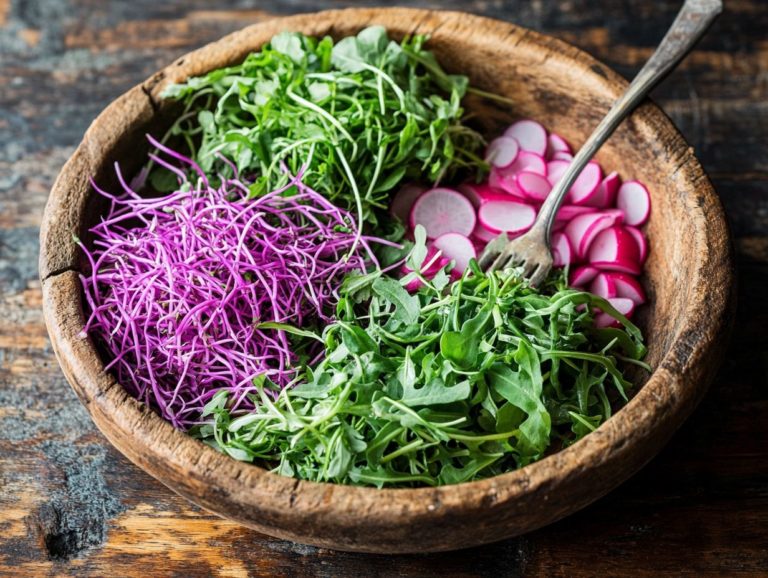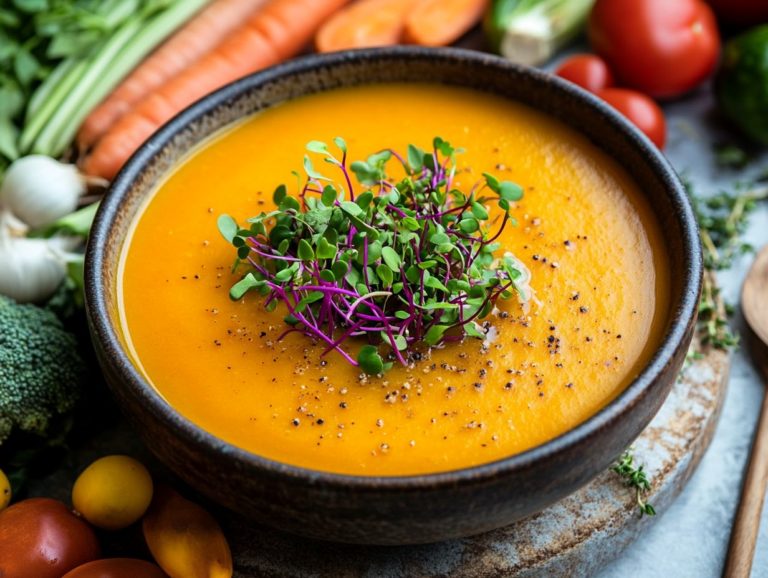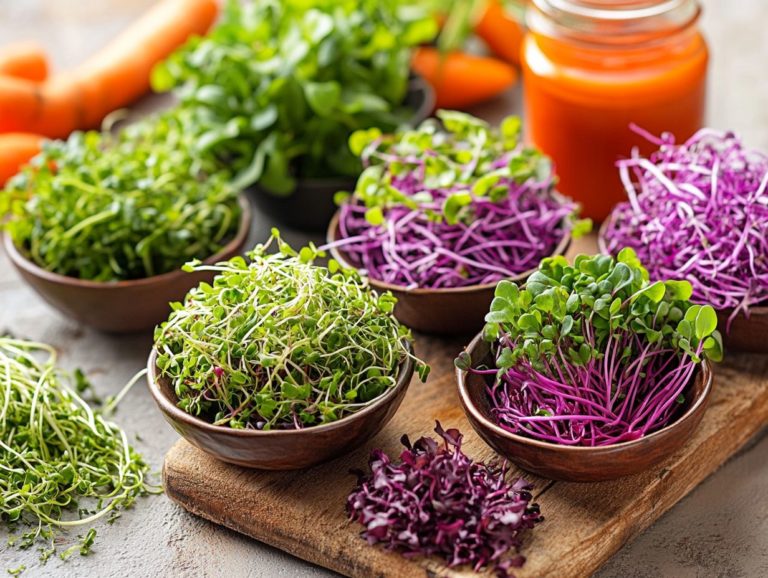42. 6 Ways to Use Microgreens in Salads
Microgreens are small, nutrient-packed greens that can take your salads to the next level. They enhance flavor, add vibrant colors, and significantly boost the nutritional value of any dish.
This article explores six exciting ways to incorporate microgreens into your salads, along with helpful tips on how to grow and store them to ensure peak freshness. This makes your meals not only healthier but also more delicious.
Discover how these miniature greens can transform not just your salads but a variety of dishes, from salsa to guacamole!
Contents
- Key Takeaways:
- 1. Add a Burst of Flavor to Your Salad
- 2. Boost Nutritional Value
- 3. Add Color and Texture
- 4. Experiment with Different Varieties
- 5. Use as a Garnish
- 6. Incorporate into Dressing or Vinaigrette
- What Are Microgreens and Why Are They Beneficial?
- Frequently Asked Questions
- 1. What are microgreens and why should I use them in my salads?
- 2. How do I incorporate microgreens into my salads?
- 3. Can I grow my own microgreens at home?
- 4. Are there any specific types of microgreens that work best in salads?
- 5. Can I use microgreens in warm salads?
- 6. Are there any health benefits to using microgreens in salads?
Key Takeaways:
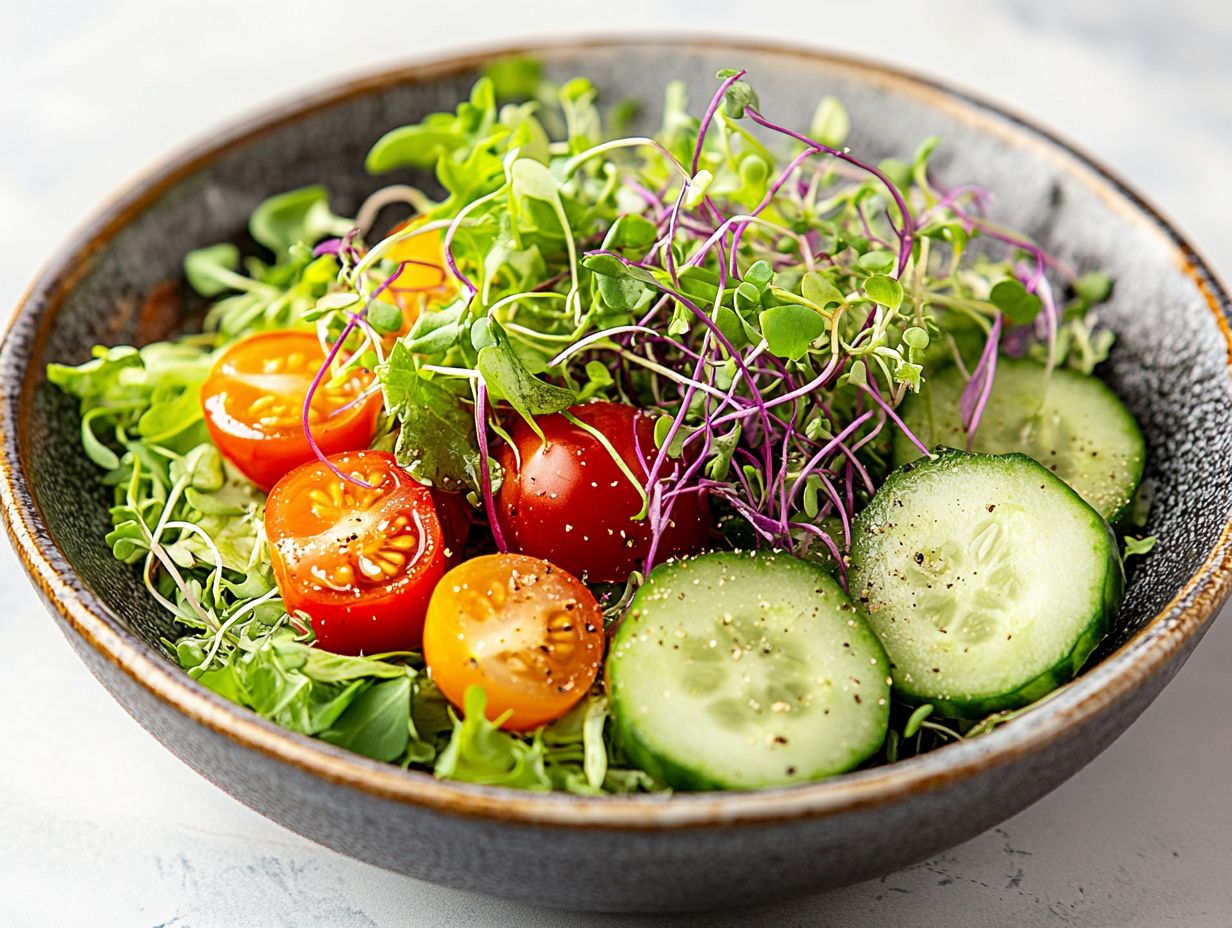
- Enhance the flavor of your salads with microgreens for a burst of freshness, perfect for wraps and tacos.
- Supercharge your salad’s nutritional value by incorporating microgreens, packed with vitamins and minerals.
- Brighten up your salads and add a satisfying crunch with colorful microgreens!
1. Add a Burst of Flavor to Your Salad
Adding microgreens to your salad creates a burst of flavor that enhances taste and introduces a fresh element to your meal. With robust flavors and crunchy textures, microgreens elevate even simple salads into something extraordinary.
Incorporating these unique greens can change the way you think about salads. They can be a standout part of your dining experience instead of just a side dish.
For instance, pairing pea shoots with sweeter lettuces offers a delightful contrast, while arugula adds a peppery kick that complements creamy goat cheese beautifully. Drizzle a citrus vinaigrette for brightness or a balsamic reduction for depth.
Simple recipes, like a salad topped with microgreens and crumbled feta, can be invigorated by toasting nuts, adding roasted vegetables for extra crunch, or incorporating them into juices and snacks.
Feel free to experiment with combinations to find the perfect balance that delights your palate!
2. Boost Nutritional Value
Integrating microgreens into your meals will elevate their nutritional value. These vibrant greens are full of vitamins, minerals, and essential nutrients that support your health.
Take broccoli microgreens, for example; they’re known for their impressive vitamin C content, which can boost your immune system. Meanwhile, kale microgreens are rich in antioxidants that help protect your cells.
Incorporating these delightful greens into your daily diet is simpler than you think. Tossing a handful of broccoli microgreens into your morning smoothie adds a refreshing twist, while layering kale microgreens in a sandwich enhances both flavor and nutritional value.
Whether you sprinkle them over salads, blend them into pestos, or use them as beautiful garnishes for drinks, microgreens can elevate your meals while promoting your health.
3. Add Color and Texture
Microgreens offer a stunning array of vibrant colors and unique textures, enhancing the visual appeal and mouthfeel of your dishes. They make your meals not just tastier but also irresistibly inviting.
Imagine sprinkling these delicate greens atop your tacos for an eye-catching pop of color or layering them in sandwiches and wraps for a delightful crunch. Their bold flavors work well with various ingredients, transforming everyday meals into culinary masterpieces.
These tiny plants are a delightful way to boost nutrition and add a playful elegance to your plates. Attention to detail in presentation can make even the simplest meals extraordinary.
4. Experiment with Different Varieties
Experimenting with various microgreens can truly open up a delightful world of flavors and textures. This allows you to tailor your meals in unique and exciting ways that reflect your personal taste. You can explore recipes designed for vegan diets.
Incorporating options like basil, mustard, and radish microgreens can elevate your everyday dishes and surprise your palate. For instance, fresh basil microgreens add a sweet and aromatic touch, making them perfect for topping a summer salad or blending seamlessly into pesto.
On the other hand, mustard microgreens deliver a peppery kick that enlivens soups or sandwiches. Then there are radish microgreens, which introduce a crisp tanginess that cuts through the richness of hearty meals.
Don’t shy away from experimenting with unique combinations. Consider adding beet or amaranth microgreens to your grain bowls for a vibrant twist. The possibilities are truly endless!
5. Use as a Garnish
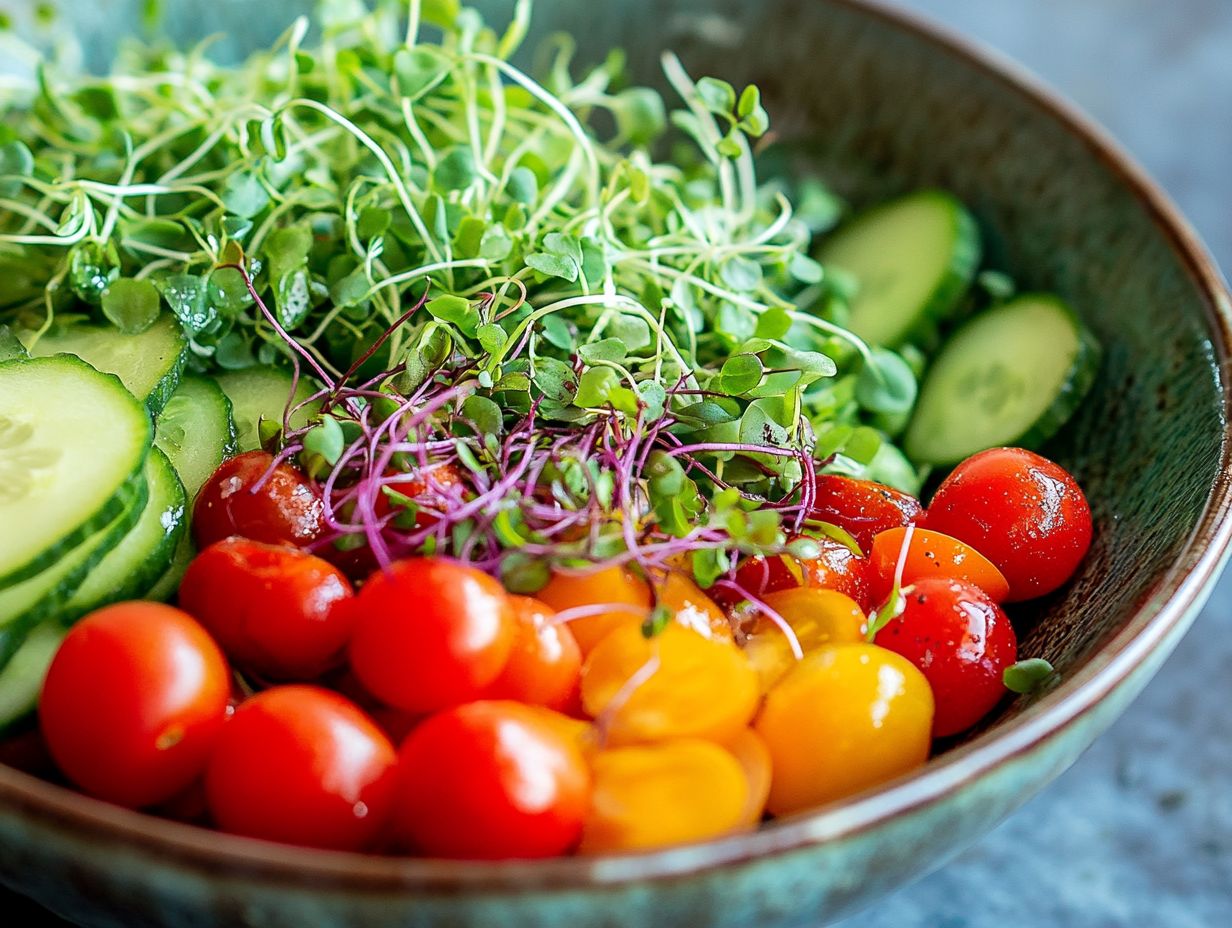
Using microgreens as a garnish can elevate the presentation of your dishes. They infuse meals with a punch of flavor that tantalizes the palate and enhances the overall dining experience, making every meal feel special.
These vibrant little greens, often brimming with nutrients, serve not just as eye-catching accents but also as bold flavor enhancers. Imagine a handful of peppery arugula microgreens transforming a simple bowl of soup into a gourmet masterpiece.
A sprinkle of vibrant radish microgreens can take your sandwiches to the next level, adding a fresh crunch and a delightful zing. If you’re curious about how to grow microgreens for a fresh salad, garnishing drinks, like cocktails or smoothies, can also add a surprising flavor boost. Delicate basil or cilantro microgreens introduce an unexpected layer of flavor that invigorates each sip.
Remember that garnishes should enrich your dish or drink. Careful selection and presentation are essential for crafting a truly memorable meal.
6. Incorporate into Dressing or Vinaigrette
Incorporating microgreens into your dressing or vinaigrette can elevate not just the flavor profile but also infuse a fresh, nutritious twist. This takes your salads to an entirely new level, making them perfect for summer barbecues.
These petite greens, brimming with vitamins and minerals, introduce an exciting burst of color and taste to your creations. Whether you favor the peppery kick of arugula or the subtle sweetness of pea shoots, blending them into your dressings can transform even the simplest salads into delicious meals.
Feel free to experiment with various techniques, like puréeing or finely chopping microgreens. This allows them to infuse their distinctive qualities throughout the dressing. For a delicious combination, imagine pairing a zesty lemon vinaigrette with a medley of mixed greens, cherry tomatoes, and cucumbers. To elevate your dish further, consider using 5 creative ways to grow microgreens and finish it off with a sprinkle of sunflower microgreens for extra crunch and a boost of nutrition.
What Are Microgreens and Why Are They Beneficial?
Microgreens are young, edible plants harvested just after their first leaves develop. They offer a concentrated source of nutrients, flavors, and culinary versatility that can elevate the taste and health value of your dishes. This makes them perfect for salads, salsas, and pestos.
These delicate greens have skyrocketed in popularity because of their vibrant colors and robust flavors. They captivate both chefs and health enthusiasts alike. Their compact size allows you to effortlessly incorporate these nutritious little plants into salads, sandwiches, and smoothies, enhancing your meals with minimal effort.
Nutritionally, microgreens often deliver more vitamins and minerals than their mature counterparts. For instance, cabbage and kale microgreens can boast vitamin C levels that are up to six times higher than those found in the mature versions.
Additionally, their antioxidant properties contribute to improved skin health and reduced inflammation, making them a valuable asset to your diet.
What Are the Different Types of Microgreens?
There s a fascinating array of microgreens, each boasting a distinct flavor profile and impressive health benefits. This variety allows you to easily find the ideal choice to elevate any dish, from tacos to wraps!
Take pea shoots, for example. They offer a sweet, delicate taste reminiscent of fresh peas, making them a delightful addition to salads or a vibrant garnish on soups.
Then there’s basil microgreens, known for their aromatic and slightly peppery flavor. They can transform your pesto, enhance pasta dishes, or simply add an extra punch to homemade salads. If you’re looking for more ways to enjoy them, check out this guide on How to Incorporate Microgreens into Your Diet.
On the other hand, arugula microgreens present a sharp, nutty flavor, perfect for infusing complexity into sandwiches or delivering a spicy kick in grain bowls. For those looking to elevate their culinary creations, exploring ways to enhance flavor in microgreens can be invaluable. Their health benefits are impressive, packed with vitamins A, C, and K, along with antioxidants. These tiny greens aren’t just delicious—they’re also beneficial for your overall health!
Incorporating these microgreens into your daily meals is a straightforward yet impactful way to boost flavor while reaping significant nutritional rewards, whether in snacks, wraps, or soups.
How Can Microgreens Be Grown at Home?
Growing microgreens at home is simple and truly rewarding! You can savor fresh, nutritious greens right from your kitchen, effortlessly elevating your meals to be more vibrant and delicious.
To embark on this delightful journey, start by gathering essential materials: seed trays, potting soil, and a variety of seeds tailored for microgreens, such as radish, arugula, or basil. Selecting a well-lit area is crucial; a sunny windowsill or a grow light can work wonders!
After you’ve sown the seeds into the damp soil, lightly cover them and maintain consistent moisture. Pay attention to the optimal growing conditions temperature and humidity can significantly influence growth. In just a couple of weeks, you’ll be rewarded with vibrant greens ready to enhance your salads, sandwiches, and garnishes in your culinary creations.
What Are the Best Ways to Store Microgreens?

Properly storing microgreens is vital for maintaining their freshness and nutritional value. This allows you to savor their vibrant flavors and health benefits for as long as possible!
To achieve this, it’s essential to grasp the ideal conditions for storage. Keep them in a cool, dark place, and opt for breathable containers to prevent moisture buildup. A temperature range of 32 to 40 degrees Fahrenheit is often recommended to preserve their crispness and flavor.
Avoid common pitfalls, such as washing microgreens before storage. Excess moisture can lead to spoilage. Keep a close eye on them and aim to consume within a week to fully appreciate their uniqueness and ensure you don’t lose any of that delightful quality.
What Are the Benefits of Eating Microgreens?
Eating microgreens introduces a wealth of health benefits into your diet! These tiny powerhouses are brimming with vitamins, minerals, and antioxidants, making them a fantastic addition that can effortlessly elevate various recipes.
Packed with essential nutrients, microgreens support immune function, promote healthy skin, and aid in digestion. For instance, take broccoli microgreens they’re renowned for their cancer-fighting properties. And let’s not overlook pea shoots, which not only add a satisfying crunch but also deliver vitamins A, C, and K!
To reap these benefits, consider the following:
- Sprinkle a handful of microgreens onto your salads for a delightful texture and burst of flavor.
- Blend them into your smoothies for an impressive nutrient boost.
- Use them as a vibrant garnish on soups and sandwiches, enhancing both presentation and healthfulness!
How Can Microgreens Be Used in Other Dishes Besides Salads?
Microgreens can be seamlessly woven into a myriad of dishes beyond the typical salad, inviting you to explore their culinary versatility in meals like tacos, wraps, guacamole, and even smoothies.
Imagine enhancing your fish tacos with a handful of vibrant radish microgreens. They add a peppery crunch that elevates the entire experience.
Alternatively, consider using pea shoots in your wraps. They bring a sweet, garden-fresh taste that simply can’t be ignored.
In guacamole, sunflower microgreens not only enrich the nutritional value but also introduce a delightful texture that complements the creamy base.
For your breakfast smoothies, blending in microgreens like kale or spinach allows you to infuse essential vitamins without overwhelming the delightful flavors you ve crafted.
You can sprinkle these tiny greens atop pasta dishes, fold them into omelets, or use them as an elegant garnish for soups. They provide both visual allure and a burst of flavor that showcases their unique characteristics.
Frequently Asked Questions
1. What are microgreens and why should I use them in my salads?
Microgreens are young, edible plants that are harvested within 14 days of germination. These little greens are bursting with nutrients and add a burst of flavor and texture to salads, making them a healthy and delicious addition to any meal.
2. How do I incorporate microgreens into my salads?
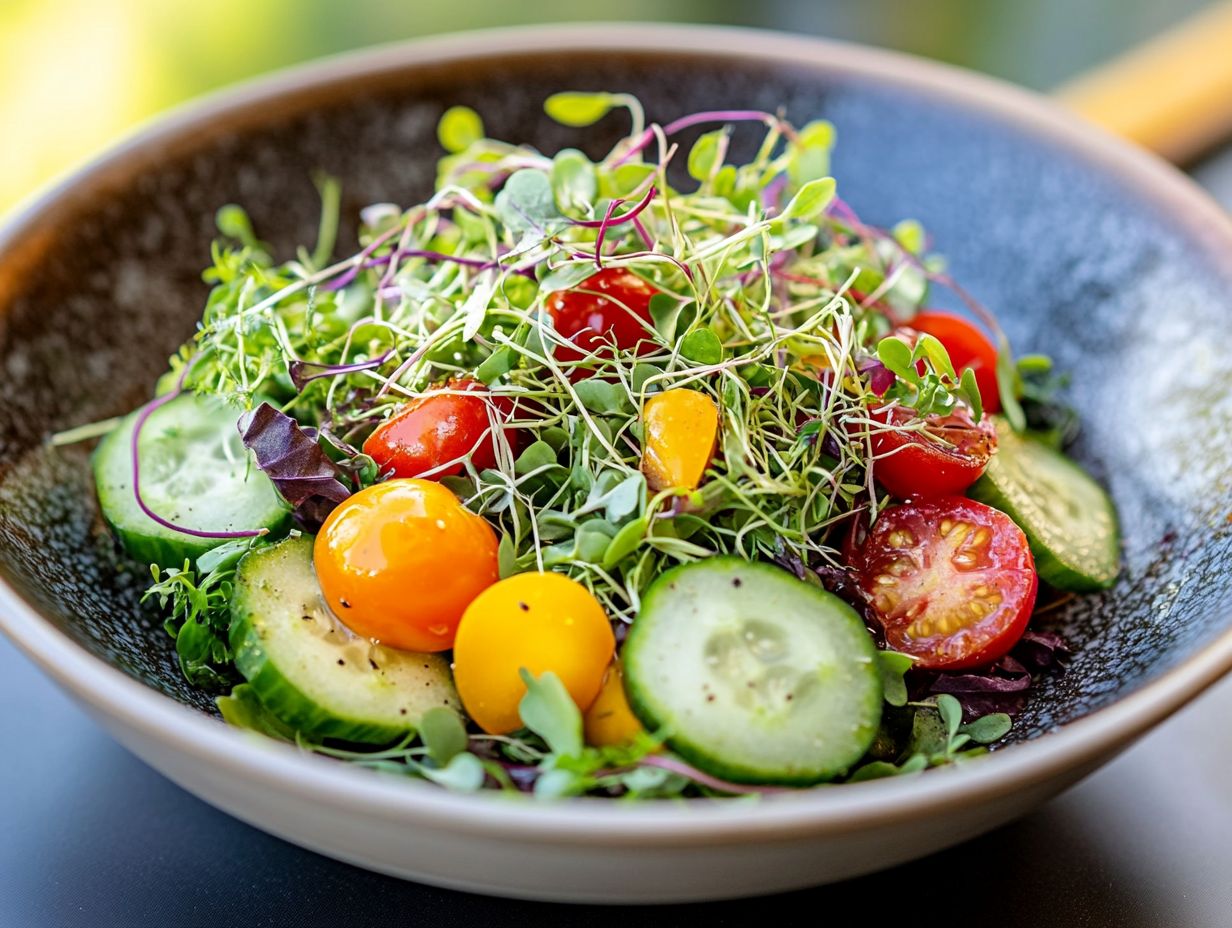
There are many ways to use microgreens in salads. You can mix them in with your other salad greens, sprinkle them on top as a garnish, or use them as the main ingredient by creating a microgreen salad. Get creative and find the way that works best for you!
3. Can I grow my own microgreens at home?
Yes, you can easily grow microgreens at home with just a few simple steps. All you need is a shallow, wide container, some potting soil, and the seeds of your choice. In just a few days, you’ll have fresh microgreens to add to your salads.
4. Are there any specific types of microgreens that work best in salads?
Most microgreens are great for salads, but some varieties are more popular and flavorful than others. Popular options include broccoli, radish, kale, and sunflower microgreens. Experiment with different types to find the ones you enjoy the most.
5. Can I use microgreens in warm salads?
Yes, you can use microgreens in warm salads as well. Add them in at the end, after the warm ingredients have cooled down slightly, to preserve their delicate texture and flavor.
6. Are there any health benefits to using microgreens in salads?
Absolutely! Microgreens are packed with vitamins, minerals, and antioxidants, making them a great addition to any salad. They also add a variety of textures and flavors, making your salad more satisfying and enjoyable.
Try adding microgreens to your next dish and discover a new world of flavor!



